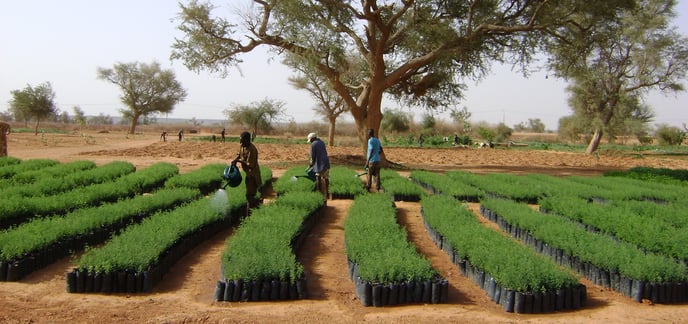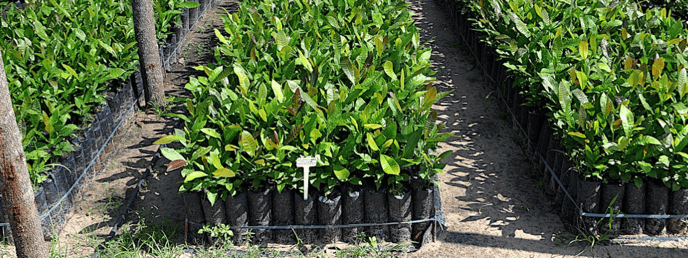Existing planting methods
At Tree-Nation we do not have just one planting method. We believe it's important to adapt to local specifications and promote various planting techniques.

There exists a wide range of planting techniques. Some very established, coming from the wood industry, often focused on results and survival rate, while some others will focus on natural selection or preserving the genetic patrimony of a local strain.
It is our belief that we should not pick a winner but allow a certain competition between techniques, and always provide room to learn and experiment. This is why our techniques range from those that simulate animals burying seeds to drones or highly engineered solutions.
Each technique has its pros and cons. A good example of this is the survival rate. If you reach a high survival rate, it seems very successful but, in fact, it also means you don't allow enough natural selection of the fittest species. In the long term, it may result in a forest that includes weaker trees that will be less resistant to pests or diseases.
Very importantly, our solutions do not only affect how we plant the trees but also how we interact with local communities that will benefit from those trees. While drones will compete against volunteers in some high-income regions, it makes much more sense to use manpower in areas where we can improve living conditions by providing good and honest jobs. You can read more about maintenance here.
Below, we will detail the main techniques we use and their benefits. Very soon we will add a section on each project page to indicate which planting techniques are used for each project.
Planting methods:

- Direct seeding
The sowing of seeds directly into the soil where the trees are to be established.
Benefits: This technique can reduce the cost of regeneration by up to 50% when compared to seedlings transplants. Trees grow strong and are also well adapted to their environment.
Cons: Low survival rate.

- Direct seeding – Muvuca
This direct-seeding method involves spreading the seeds of hundreds of varieties of native species over every square meter of land.
Benefits: Instead of the planter, this technique lets nature make its own selection of which species will grow in which spot. Depending on the soil composition, the species that are best fitted will grow, in a sort of Darwinian natural competition. It also creates more natural spread vegetation and dense forest.
Cons: Low survival rate and you need a vast number of seeds that, in some cases, may be hard to find.

- Direct seeding – Seed bomb
One seed, or multiple, wrapped in a mixture of clay and compost, protecting the seed from harsh weather conditions and seed-eating animals.
Benefits: Easy to manipulate and quick to plant, this technique can also be used to throw seed bombs in difficult-to-reach areas.
Cons: Wrapping the seeds is very time-consuming.

- Direct seeding – Aerial seeding
The technique of sowing seeds by dropping them from a drone, plane, or helicopter. This method allows dispersing seeds into difficult-to-reach locations.
Benefits: This technique is still experimental but if well mastered, it may allow a cheap and automated method to plant at a large scale.
Cons: Low survival rate: a high number of seeds can simply be eaten by wild animals.


- Nursery seedlings transplant
Seedlings transition from the nursery to their permanent site. Seedlings spend 3-6 months in nurseries before being transplanted, usually during the rainy season. The seedling bags are usually plastic. In this case, the seedlings are removed from the bag to be transplanted into the soil.
Benefits: This technique is the most widespread in tree planting. It allows an orderly and professional approach to planting trees with great control on quantities planted, species, and survival rate.
Cons: Disposal of plastic bags can be an issue. Seedlings grow in optimum conditions while in a nursery and are then transplanted to the real world. While trees may maintain a high survival rate in the first years, they are less well adapted to their environment once in the wild.

- Nursery biodegradable seedlings bags transplant
Seedlings transition from the nursery to their permanent site. In this case, the bags used are biodegradable, so there is no need to remove the seedlings, reducing the risk of a transplant shock.
Benefits: This technique has the obvious benefit of not using any plastic in its process.
Cons: Higher cost, harder to produce, and often fragile to manipulate. Seedlings grow in optimum conditions and are then transplanted to the real world, so a lot of seedlings don’t survive in the wild.

- Assisted natural regeneration
Protection and preservation of natural tree seedlings in forested areas employing different techniques to remove or reduce barriers to natural forest regeneration.
Benefits: It's a very natural approach and well suited to existing forested areas while also inexpensive.
Cons: With this technique, the results take longer to measure and the trees are harder to count.

